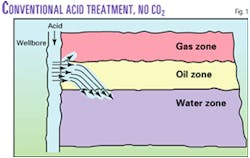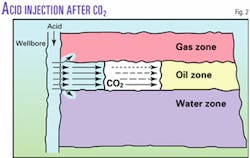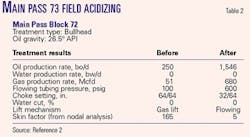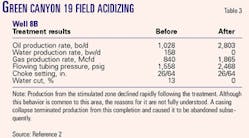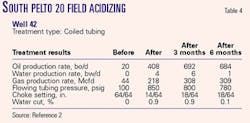Carbon dioxide (CO2) pumped ahead of an acid treatment preconditions the formation and overcomes sandstone acidizing problems that may occur with conventional treatments.
Conventional treatments can have problems such as stimulating water preferentially, inadequately removing damage, and often causing significant upsets in demulsification facilities because of spent-acid returns.1
CO2-acidizing jobs should include enough CO2 to completely displace resident crude oil from the zone to be contacted by acid.
Sandstone acidizing
There is a fundamental difference between sandstone and carbonate acidizing. In the latter treatment, hydrochloric acid dissolves carbonates into products that are soluble in the spent acid. After the treatment, one generally can flush these products from the formation without difficulty.
In sandstone acidizing, formation materials precipitate when the acid is spent. These materials are primarily clays and feldspars dissolved by hydrofluoric and other acids. They remain insoluble in spent acid and make it difficult to clean up the formation after the treatment.
If the precipitants come in contact with crude oil, they may form sludges or emulsions that damage the formation and destroy the improvements made by the acid treatment.
Including CO2 in the treatment to displace crude oil from the area to be acidized can prevent the interaction of the crude with spent-acid precipitates. This allows the acid to remove damage without developing materials that impede flow and are difficult to remove from the formation.
Conventional acidizing
Conventional acidizing without CO2 preconditioner, frequently stimulates water more than oil. This depends somewhat on lithology, but it is especially prevalent in blanket sands without a physical barrier, such as a shale break to isolate the oil and water zones.
Fig. 1 illustrates conventional sandstone acidizing. Typically, a well produces oil until it is shut in to be acidized. At that point, the zone to be acidized contains a high oil saturation. As the job pumps acid into the oil-saturated zone, the high oil saturation creates low relative permeability to acid and makes the zone resistive to acid penetration.
In seeking the path of least resistance, the acid underrides the oil zone and heads for the water zone because of its greater density and the unfavorable relative permeability.
As the job pumps more acid into the well, the acid's reaction with the formation increases permeability, facilitating the conductivity of the path from the wellbore to the water zone. This can increase water production and the preferential stimulation of water rather than oil.
CO2 acidizing
Fig. 2 illustrates the CO2-acidizing process. Xylene and CO2 are the first fluids to enter the formation.
Xylene readily penetrates the oil-saturated zone because of its favorable relative permeability to oil. Next pumped is the CO2.
The low CO2 viscosity, about one-tenth that of water, and the unfavorable mobility ratio of the displacement cause CO2 to:
- Finger into the oil zone.
- Be absorbed by the oil.
- Swell the oil.
- Reduce oil viscosity.
Displace oil completely from the wellbore vicinity, if enough CO2 is used.
The acid now easily penetrates the producing zone, filled with CO2, because it is the path of least resistance.
The two benefits of the process are that:
- It concentrates the action of the acid on the producing zone and makes it more effective for damage removal.
- It avoids underriding the oil zone and keeps acid out of the water zone. This eliminates preferential stimulation of water.
Water stimulation
Field tests of the CO2-acidizing process conducted on BP PLC's wells in Gulf of Mexico West Delta Block 73 field revealed that the key for eliminating preferential water stimulation was to include enough CO2 to cleanly displace crude oil from the zone to be acidized.1
This process fills the productive zone with CO2, and CO2 can be displaced easily by acid, thus preventing the acid from entering the water zone.
Table 1 shows the water cut change in 10 treatments.
The increase in water cut in three treatments indicates that these treatments preferentially stimulated the water. These treatments employed less CO2, thus showing that too little CO2 leads to an incomplete displacement of oil near the wellbore and results in acid entering the water zone.
The remaining seven treatments, with one exception, avoided preferential water stimulation, thus illustrating the effectiveness of an adequate displacement of oil by CO2.
The single exception results from entering in the record the water cut value on one test prior to the stabilization of water production.
A variety of wells with many different acid formulations have included CO2-acidizing in the Gulf of Mexico. To date, only two of the more than 50 treatments have failed. These treatments failed because they departed from recommended procedures in either design or execution.
Gulf of Mexico treatments
Table 2 shows the results on a gravel-packed well in Mobil Oil Corp.'s Main Pass 73 field, off Louisiana.2 Prior to the treatment, the well produced 250 bo/d and had a skin factor of 165. After the CO2-acid treatment, production increased to 1,546 bo/d with a skin factor of 5 on a choke half the size as prior to the treatment.
One year later with the choke at the larger original setting, the well produced more than 2,400 bo/d with no increase in water production.
Table 3 shows a Mobil well in the Green Canyon 19 field.2 The treatment increased production to 2,803 from 1,028 bo/d with a net reduction in water production.
Reduced water production directly relates to a reduction in drawdown on the well and less water coning. Effective stimulation often allows oil production with less drawdown that in turn reduces water coning problems.
Table 4 shows results from a well in Murphy Oil Corp.'s South Pelto 20 field.2 The stimulation response, which was quite good immediately after the treatment, improved over the next several months.
These results indicate that CO2, which has usually gasified by the time it has reached the formation, builds a gas saturation in the formation that temporarily reduces the relative permeability to oil through the stimulated zone.
Because of its solubility, however, CO2 becomes absorbed by the oil flow and is completely removed in a matter of months.
Nitrogen, on the other hand, when used in oil well stimulation, builds a relatively permanent gas saturation that is not removed in a matter of months because of its relatively low solubility in oil. It, therefore, reduces the stimulation effectiveness over a longer period.
Table 5 depicts the experience of Pennzoil Corp. in using the CO2-acidizing process in the Sabine Pass 13 field.2 The stimulation effect improved over several months following the treatment.
While this effect is not uncommon, it is in marked contrast to the usual experience with conventional sandstone acidizing, where the stimulation effect is the greatest immediately after acidizing and usually declines thereafter.
Conventional-vs.-CO2 acidizing
There is little agreement in the industry on how to compare two different methods of acidizing. One method is to compare two wells that have similar damage, as indicated by their skin factors and production rates before the acid treatment.
Conoco Inc. published results of conventional acid treatments in the Main Pass field,3 which is in the same general area of the Mobil well described in Table 2.
Table 6 compares the treatments in the Conoco and Mobil wells. As shown, all three wells initially had skin factors in the narrow range of 165-70. After the acid treatments, skin factors varied widely.
The two conventional acid treatments produced skin factors ranging from 50 to 114. While these numbers reveal substantial damage remaining after acidizing, oil production roughly doubled in both cases.
On the well with the CO2-acid treatment, a skin factor of 5 remained after the treatment. This number reveals some damage remaining, but oil production was increased by more than six-fold.
Demulsification upsets
The spent acid from conventional treatments usually will upset the processing facility and may require major efforts to restore the demulsification process.
While not all CO2-acidizing treatments have completely eliminated this problem, one example illustrates the potential of the process.
For example, BP CO2-acidized three wells during the development phase of a field in the Gulf of Mexico. These were treated in 1 week during which the facility processed the spent-acid returns without any upsets.
The chemical treatment of the flow remained unchanged from that being used for existing production.
Applicability
Most applications of the process have been on damaged offshore gravel-packed wells, but there is no technological reason that the application should be limited to offshore wells. What is limiting, however, is the need to apply the treatment only to damaged wells.
A positive skin factor is the best indicator of damage, but in the absence of that information, other indicators may sometimes be used.
The point to be recognized, however, is that the treatment will not provide productivity improvement in an undamaged well. Application of the treatment to such a well will waste time, effort, and resources.
Application method
CO2-acidizing has included both bullhead and coiled-tubing treatments, although the majority of treatments were pumped through coiled tubing.
CO2 arrives at the wellsite as a refrigerated liquid at –14° to 0° F. and 300 psi. Most jobs pump the CO2 into the well under refrigerated conditions.
Handling the cold liquid has not been a problem and contrary to many admonitions, ice plugs have not blocked flow or presented hazardous conditions. The sequence employed in injecting the fluids precludes this problem, and service company personnel handling the treatments are trained on safety procedures and take adequate steps to prevent unsafe conditions.
The treatments are not more hazardous than conventional acid treatments.
The recommended treatment injects all fluids at the maximum nonfracturing injection pressure. By adjusting the injection rate, one assures that the fluids maintain a constant injection pressure throughout the entire treatment. This technique, whose usefulness has been pointed out by Paccolini,4 appears to provide effective diversion.
This recommended procedure is better for assuring the proper sequence of fluid entry than if one injected the fluids at a constant rate and allowed the pressure to vary. The latter procedure has led to failures.
Availability
CO2-acidizing is a patented process that is licensed to both Halliburton Energy Services and Schlumberger Oilfield Services. The treatments, particularly offshore, require a significant investment in US Department of Transportation (DOT) approved container vessels for safely transporting the refrigerated liquid CO2.
Acknowledgments
We thank the companies that provided financial support for developing the process and to those that released the treatment results. The authors also thank Syed Ali of ChevronTexaco E&P Technology Co. for his critical reading of the manuscript and to BP PLC for some of the material and figures.
References
- Gidley, J.L., Brezovec, E.J., and King, G.E., "An Improved Method for Acidizing Oil Wells in Sandstone Formations," SPEPF, February 1996, pp. 4-10.
- Harvey, R., Jr., Smith, C.J., Wylie, M.P., Eberhard, J.E., Chapman, B.J., Vitthal, S, and Gidley, J.L., "New Acidizing Techniques Prove Useful in the Offshore Environment," Paper No. SPE 39481, SPE International Symposium on Formation Damage Control, Lafayette, La., Feb. 18-19, 1998.
- Brannon, D.H. Netters, C.K., and Grimmer, P.J., "Matrix Acidizing Design and Quality-Control Techniques Prove Successful in Main Pass Sandstone," JPT, August 1987, pp. 931-42.
- Paccaloni, G., "A New, Effective Matrix Stimulation Diversion Technique" Paper No. SPE 24781, SPE Formation Damage Control Symposium, Bakersfield, Calif., Feb. 8-9, 1988.
The authors
John L. Gidley is president of John L. Gidley & Associates Inc., a well stimulation consulting firm in Houston. He previously worked 31 years for Exxon Corp. and following his retirement, served as a visiting professor in the petroleum engineering department at Texas A&M University. Gidley holds a PhD in chemical engineering from the University of Texas at Austin. He is an SPE member and in 1994 was elected to the National Academy of Engineering.
George E. King is a distinguished advisor in BP PLC's well performance group in Houston. He has worked in completions, stimulations, intervention, and sand control for more than 31 years and taught 11 years as an adjunct professor at the University of Tulsa. King has a BS in chemistry from Oklahoma State University, and a BS in chemical engineering and an MS in petroleum engineering from the University of Tulsa. He is an SPE member and is API subcommittee chair on perforating.

